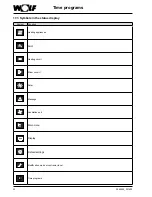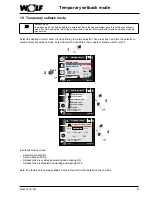
38
3064202_201602
Energy saving tips
22 Energy saving tips
Room temperature (day temperature)
Set the room temperature high enough so that it feels pleasant.
A room temperature that is one degree higher than necessary represents an
additional energy consumption of approx. 6 %.
Do not heat rarely used rooms or bedrooms continuously.
Efficient heating
Heat all rooms in the house or apartment.
A single heated room heats the adjoining rooms unchecked. Heat the rooms
according to use. Maintain a minimum temperature in all rooms. In unheated
rooms, moisture can form on the walls and damage the building structure.
Thermostatic valves
Thermostatic valves maintain the set temperature. They open at low room
temperature and close automatically when the temperature rises. Leave all
thermostatic valves fully open in the room where the BM-2 programming unit
is located, because otherwise the thermostatic valves and programming unit
could influence each other.
Maintenance of the heating system
Soot deposits in a boiler combustion chamber or a poorly adjusted burner
can easily reduce a heating system’s efficiency by 5 % or more. Regular
heating system maintenance by your local heating contractor can therefore
quickly pay off.
Easily accessible radiators
Air must be able to circulate freely near the radiators, otherwise the heating
system will lose effectiveness. Modern radiators emit some of their heat as
radiant heat. Long curtains or poorly positioned furniture can swallow up to
20 % of energy.
Keep the heat inside the room – at night too!
At night, closing blinds and drawing curtains noticeably reduces heat loss via
the window areas. Thermally insulated radiator recesses and light coloured
paintwork can save up to 4 % on your heating bills. Airtight joints at windows
and doors also help to keep energy inside the room.
Ventilation
Ventilate the rooms by turning the thermostatic valves down low and
opening wide all the windows in the room, or preferably the whole house or
apartment if possible: this is known as peak ventilation. Brief and effective
ventilation replaces the air in the room, and the room quickly warms up again
as the heat stored in the furniture and walls is emitted back into the cool air.
Bleeding radiators
Regularly bleeding the radiators in all rooms, particularly on the upper floors
of apartment buildings, ensures that radiators and thermostatic valves
continue to operate smoothly. The radiator responds quickly to changing
heat demands.







































